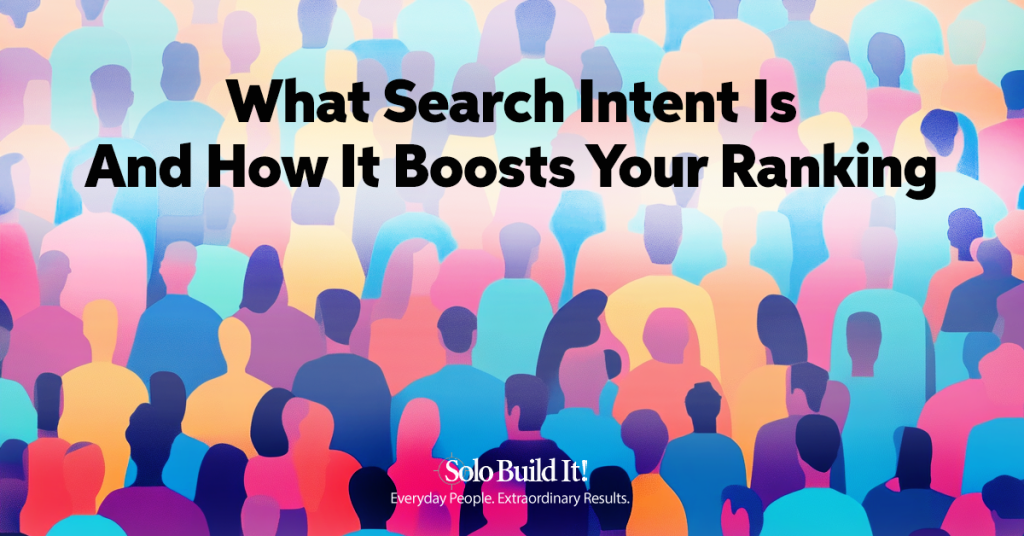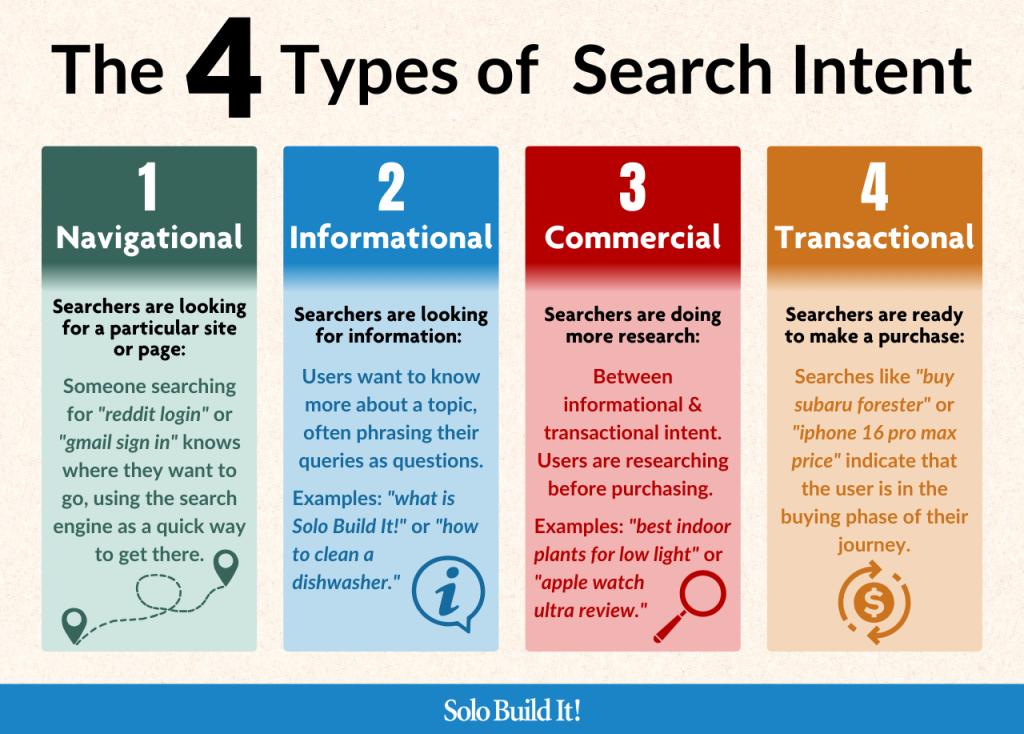Understanding your target audience is key to your success in the online business world and one important aspect of this understanding is search intent.
Whether you’re a seasoned marketer or just starting your online business journey, grasping the concept of what search intent is can significantly impact your writing and marketing strategies and overall online presence.
So, what is search intent, exactly? Read on to find out!
Defining What Search Intent Is
Search intent, also referred to as user intent, is essentially the underlying reason behind someone typing a given query into Google or any other search engine. It represents the user’s goal or objective when performing a search. Are they looking for information? Trying to make a purchase? Or perhaps wanting to navigate to a specific website?
Understanding these motivations is crucial for creating content that meets users’ needs and ranks well in search engine results pages (SERPs).
Let’s consider an example to illustrate this concept. Imagine someone searches for “best dog food” on a search platform. At first glance, you might think they’re ready to buy dog food. However, a closer look reveals that they’re likely in the research phase, comparing different options before making a decision.
This important piece of insight can guide your content strategy and help you create more relevant, valuable information for your audience.
The Four Types of Search Intent
To better understand and categorize search intent, we typically divide it into four main types:
- Navigational Intent: Searchers with navigational intent are looking for a particular site or page. For example, someone searching for “reddit login” or “gmail sign in” knows exactly where they want to go and is using the search engine as a quick way to get there.
- Informational Intent: This type of intent is all about learning. Users with informational search intent want to know more about a topic, often phrasing their queries as questions using words like who, what, where, why, and how. Examples include “what is Solo Build It!” or “how to clean a dishwasher.”
- Commercial Intent: Commercial intent sits between informational and transactional intent. Users with this intent are researching before making a purchase decision. They might search for “best indoor plants for low light” or “apple watch ultra review.”
- Transactional Intent: Users with transactional intent are ready to take action, often making a purchase. Searches like “buy subaru forester” or “iphone 16 pro max price” indicate that the user is in the buying phase of their journey.
Understanding these different types of intent is crucial for creating content that aligns with your audience’s needs at various stages of their journey.
Why Is Search Intent Important for Ranking?
Now that we’ve defined search intent and its types, let’s explore why it’s so critical for your ranking efforts.
Improved Search Engine Rankings
Search engines, particularly Google, have invested heavily in understanding and interpreting user intent. Their primary goal is to provide the most relevant results for users’ queries. By aligning your content with the appropriate search intent, you increase your chances of ranking higher in search results.
For example, if you’re targeting the keyword “best dog food,” creating a product page for your top-selling dog food brand might seem logical.
However, a quick look at the search results shows that Google considers this a commercial intent keyword, favoring review articles that compare multiple brands.

Understanding search intent allows you to create content that better matches what Google (and users) expect to see for this query.
Better User Experience
When your content aligns with user intent, visitors are more likely to find what they’re looking for on your site. This improved user experience can lead to longer time on page, lower bounce rates, and higher engagement metrics – all factors that can positively influence your rankings.
Increased Conversion Rates
By targeting the right intent at each stage of the customer journey, you can guide users through your marketing funnel more effectively.
For example, informational content can attract and educate potential customers, while transactional content can help convert those ready to make a purchase.
More Effective Content Strategy
Understanding search intent also allows you to create a more targeted and effective content strategy. You can focus on producing content that meets specific user needs at different stages of their journey, rather than creating content that may not resonate with your audience.
How to Determine Search Intent
While sometimes the intent behind a search query is obvious, other times it may require a bit more investigation. Here are some methods to help you determine search intent:
- Analyze the Keyword: Often, the search term itself can give clues about intent. Question words like “what” or “how” usually indicate informational intent, while words like “buy” or “price” suggest transactional intent.
- Check SERP Features: The types of results Google displays can provide insight into the perceived intent. For example, shopping ads might indicate transactional intent, while featured snippets often appear for informational queries.
- Study Top-Ranking Content: Examine the content currently ranking for your target keywords. What content type is it? How is it structured? This can give you valuable insights into what Google considers relevant for that query.
- Use Keyword Research Tools: Many keyword research tools include intent analysis as part of their keyword research features. These can be invaluable for quickly assessing intent across a large number of keywords.
Implementing Search Intent in Your Strategy
Now that you understand the importance of search intent, how can you apply this knowledge to your marketing strategy? Here are some key steps:
- Conduct Thorough Keyword Research: Tools such as Brainstorm It! and Tai (both are part of Solo Build It!’s integrated suite of tools) can help you identify keywords relevant to your business, and pay attention to the intent behind each keyword.
- Create Intent-Aligned Content: Develop content that matches the intent behind your target keywords. This might mean creating in-depth guides for informational queries, comparison articles for commercial intent, or optimized product pages for transactional keywords.
- Optimize Existing Content: Review your current content and ensure it aligns with the intent of the keywords it’s targeting. You may need to make adjustments or create new content to better match user intent.
- Monitor and Adapt: Keep an eye on your rankings and user engagement metrics. If a page isn’t performing as expected, reassess the intent behind the target keyword and adjust your content accordingly.
Search Intent Is Critical For Ranking High In Search Engines

Understanding and optimizing for search intent is no longer optional; it’s essential. By aligning your content with user intent, you not only improve your chances of ranking well in search results but also provide more value to your audience.
Whether you’re just starting your online journey or looking to improve your existing website’s performance, focusing on what search intent is can make a significant difference. It’s about creating the right content for the right audience at the right time in their journey.
Ready to take your marketing strategy to the next level?
Sign up for our newsletter to receive regular updates, tips, and insights on search intent and online business success.
Don’t miss out on the latest strategies to help your website thrive in the digital landscape. Subscribe now and start optimizing your content for better search performance.
Also Read: The Importance of Website Content (Create a High-Quality Website)

Latest posts by Margit Streifeneder (see all)
- From Traffic Peaks to Auto-Pilot: A Psychologist’s Website Success Story - March 27, 2025
- From Swim Teacher to Solopreneur: Building Passive Income Online - February 27, 2025
- From Concierge to Global Tours: 10 Lessons for Travel Business Growth - December 19, 2024



